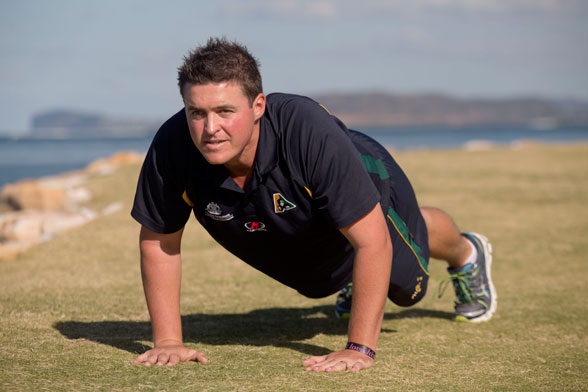The weight is over for Sherriff
Like any sport, lawn bowls will catch you out if you’re not at your physical peak (no, we haven’t just returned to work after a few lunchtime sherries at our local bowlo). The importance of fitness to lawn bowlers has even been discovered by one of the best in the business, Aron Sherriff. The 28-year-old, who bowls for Ettalong on the New South Wales central coast, has dropped 30kg over the past two years and is looking and feeling great for Glasgow 2014, his second Commonwealth Games tilt after he wore the green and gold at Delhi (he dislocated a shoulder in a team bonding session while white water rafting six weeks before those Games, but still competed). Sherriff debuted for Australia in 2007, winning the World Team Cup at Tweed Heads. In 2010 he claimed a World Championship in singles and two years later helped take out the World Fours and placed second at the World Pairs. He’s been named world bowler of the year by his peers for the last three years … so why did he have to lose all that weight – he was travelling fine, wasn’t he? Yep, he was, but Sherriff has been around long enough to know that if you’re not at the top of your game physically and mentally, the competition will catch you and pass you at the back end of tournaments. We’re not talking senior citizens who are easy to blow away here: the average age of Australia’s men’s bowls squad at Glasgow is just 34, while for the women it’s 27. Sherriff will be bowling in the all-important singles role for the Aussies, in a sport where ten golds will be up for grabs. We’re glad he’s fit and firing: here’s how he’s remodelled himself into a lawn bowls machine. IN THE BEGINNING “When I was ten years old, my dad Tony was a social bowler. I’d roll my bike down and watch him play after school. A coach at the club at the time asked me if I was interested in trying bowls out. I was into as much sport as possible when I was a young bloke, so I thought I’d give bowls a go. Back then I didn’t even have an opinion of the sport; I didn’t know too much about it. It was an opportunity for me to play a sport with my father; that was the good thing about it. Once I found myself being picked in rep teams, my dad gradually gave the game away and became my biggest supporter; drove me around and watched me play. I suppose his bowling career suffered because of mine … I grew up near Budgewoi, on the NSW central coast. Halekulani was my first club; that’s where I started. My coach was George Dawes. He was a state player for NSW and ACT at the time. He was a great guy to be learning from.” ENDURANCE SPORT “When I debuted for Australia back in 2007, there was already a high-performance program in place. It took me a little while to embrace it, but I now know that it is relevant to being at the top of your game for as long as you have to be for these major events. At the Commonwealth Games we’re competing for nine days. People think lawn bowls is easy, but we put in a lot of time to get to the level we’re at. The World Championships, in summer, in Adelaide, was about a 15-16-day event. To be competing at an international level for 15 days, your fitness has to be spot-on. I suppose the beauty of our sport is that you can play it on so many different levels; you can go out and play casually or try to be the best you can be and represent internationally. There are so many demographics which bowls appeals to on so many scales. It’s why I love it.” WEIGHTY ISSUES “I had always believed in my bowling ability, but up until 2011 I was ‘getting away’ with being overweight. After the last major event before the 2012 Worlds, the Aussie coach Steve Glasson sat me down for a debrief. He identified that my best performances were at the start of tournaments. Towards the end of these 11-12-day events, my form was still pretty good, but it had certainly dropped off. Steve identified that my level of fitness wasn’t good enough. From that point, I decided I was going to do something about it. Bowling …



